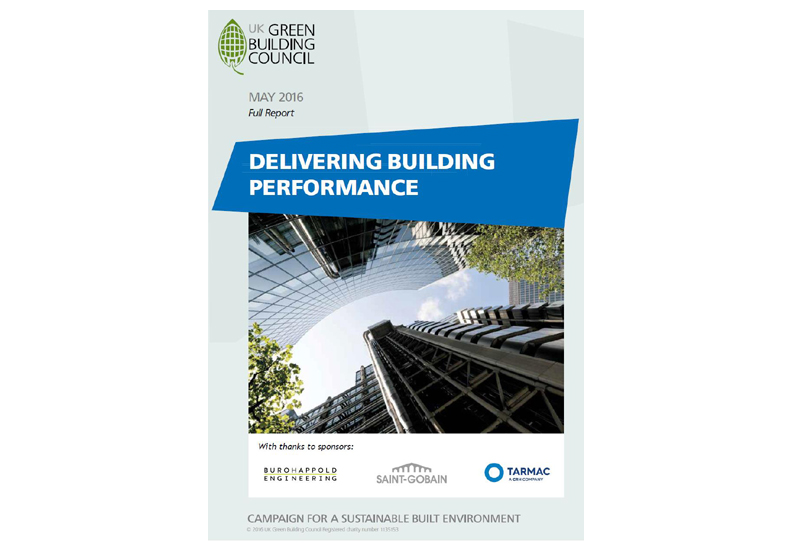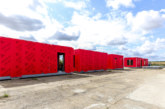
The ‘Delivering Building Performance’ report from the UK Green Building Council (UKGBC) puts forward its ideas for a sustainable built environment.
The opening statement of the review claims that: ‘The performance in operation, of the vast majority of our buildings, is simply not commensurate with the challenge of meeting our carbon targets. It also damages our ability as an industry to deliver other positive sustainability outcomes — including providing spaces that enable health, wellbeing and productivity for occupiers.’
Research on the subject is both desk based and drawn on existing work, as well as face to face interviews with a series of stakeholders from across the building life cycle — examining behaviours and processes that affect building performance. Most interviewees stressed the importance of Post-Occupancy Evaluation.
The interviewees argue it can assist in verifying other metrics not related to consumption, such as indoor environmental quality metrics and the wellbeing of occupants. Although the report focusses on the commercial sector, rather than public sector, UKGBC says that much of the analysis is relevant to both.
Learning and development
The business case includes reducing costs, meeting market demand, providing superior financial performance and improving employee recruitment, retention and productivity. It says: ‘The findings and recommendations will inform our ever growing programme of learning and development courses and activities, and we will seek to build momentum through our Sustainability 360 Review Process with Gold Leaf members, and a range of upcoming work on the business case.’
Five key areas are highlighted in the report:
- Aspiration — Expect a building that performs as required in use. Setting a simple target — at the very least for energy use (kWh/m2) — should help create a common language and shared aspirations across the delivery process. This is relevant to all sectors, but it is particularly incumbent upon investors and developers to drive this.
- Control — Collaborative contracting, with performance guaranteed and control maintained throughout the delivery process helps to ensure predictable outcomes. Delivery process helps to ensure predictable outcomes. Again, investors and developers can set expectations, but those in the supply chain should take greater ownership during procurement. There is a role for lawyers to support these aspirations, rather than revert to a default position of least-risk.
- Design for performance — Performance improves when aspirations are not limited. Do not design simply for compliance. Performance improves when aspirations are not limited to compliance or, in other words, ‘going for the ceiling, not the floor’. There is a responsibility on architects and engineers, not just their clients, to educate and advocate, making the business case for higher performance — including the benefits of sustainable design on staff productivity.
- Feedback — Reciprocal links and a commitment to monitor and feedback, particularly during the handover process, is vital. So too is giving time for well documented building commissioning. ‘Links must be made between operational facilities management (FM) and the design team, and between FM and building occupiers.
- Knowledge — Improved knowledge is needed across all professions in order for each part of the supply chain to play its part in delivering building performance. Every organisation has a responsibility to assess the knowledge levels of staff, involve HR teams and identify training needs. Organisations also need to participate more openly in lesson-sharing activities.
Case study
AHR has completed the new Keynsham Civic Centre and One Stop Shop for Bath & North East Somerset Council (B&NES) in 2015. In addition to providing the Council with high quality offices, civic facilities and public realm, the project is on course to be one the lowest energy consuming public buildings in the UK, targeting an Display Energy Certificate (DEC) A operational rating.
The new development has replaced 1960s buildings to provide 68,000ft2 council offices, a library and one-stop shop, 20,000ft2 retail, two new pedestrian streets, a market square, car parking and highways improvements. At the heart of the brief was Bath & North East Somerset Council’s objective of creating a highly efficient, robust and flexible building that would minimise energy consumption and maintenance while providing first class civic facilities and a high quality workplace embodying a ‘one council’ culture.
AHR built on extensive in-house research and worked closely with Environmental Engineers Max Fordham to develop a pioneering strategy for achieving the target set out by B&NES: it is the first in the UK to implement BSRIA Soft Landings to contractually target an exemplary DEC A rating, which it is expected to achieve in 2017 once it has been in use for two years. This rating will confirm Keynsham Civic Centre as one of the lowest energy consuming public buildings in the UK. The project has already achieved energy cost savings of over 96% during the first year of its operation.








